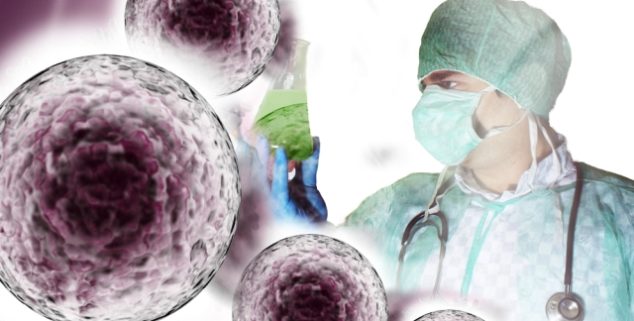News
Stem cell money flows, as search expands for ‘miraculous’ cures
 Photo illustration of a doctor analyzing stem cells. (Image: CI Photos, via Shutterstock)
Photo illustration of a doctor analyzing stem cells. (Image: CI Photos, via Shutterstock)California’s stem cell agency, created as a way to develop revolutionary cures based on human embryonic stem cells, has awarded $316 million over the last 12 months, with the bulk of its research spending going for a type of therapy that was not even on the agency’s radar when it was created in 2004.
The research involves genetic treatments and has been described as having “miraculous” potential by federal officials. The burgeoning field is expected to draw millions more from the state stem cell agency, which last week expanded the scope of what it can finance.
“Dozens of new biotech companies have launched, while scientists have taken forward breakthroughs in gene editing science to open up new treatment possibilities.” — BioPharma Dive
The move clears the way for the state agency to enter such arenas as mRNA, which was key to the development of the Covid-19 vaccines, and to fund research that could lead to the creation of vaccines for neurodegenerative diseases, according to the agency.
Gene therapy is a hot area in biomedicine nowadays. “Most of the world’s largest pharmaceutical companies have invested in gene therapy, as well as cell therapies that rely on genetic modification,” the industry online news site, BioPharma Dive, reported earlier this year.
“Dozens of new biotech companies have launched, while scientists have taken forward breakthroughs in gene editing science to open up new treatment possibilities.”
Gene therapy research is not without risks as one former darling of the stem cell agency disclosed Wednesday. Orchard Therapeutics PLC announced that it was laying off 30 percent of its workforce, in all 65 persons. Orchard was once supported with $20 million in stem cell agency funding to produce a cure for the ‘bubble baby” disease but abandoned it nearly two years ago to pursue what it believed would be more profitable therapies.
That sort of research was not mentioned in the 2004 ballot measure (Proposition 71) that created the agency — officially known as the California Institute for Regenerative Medicine,
Orchard’s stock price sank to 76 cents per share in trading Wednesday compared to a high of more than $20.00 in 2019.
CIRM initially moved tentatively into genetic research, beginning in November 2018. It was then that the agency first approved financing gene therapies, but only as a “vital research opportunity.” Now state-financed genetic research is enshrined in law as the result of voter approval of Proposition 14 of 2020.
That sort of research was not mentioned in the 2004 ballot measure (Proposition 71) that created the agency — officially known as the California Institute for Regenerative Medicine (CIRM) — and backed it with $3 billion borrowed by the state. During the campaign, voters were led to believe that nearly miraculous stem cell therapies were right around the corner.
“The mRNA research has exploded to include multiple applications that are really important to us, such as the area of multiple sclerosis as an autoimmune disease…” — Alba Creasy
By 2020, CIRM was broke and ready to close its doors. CIRM-financed research had not created stem cell treatments that could be used by the general public and still hasn’t. But voters still had faith and narrowly approved Proposition 14, which borrowed another $5.5 billion and saved CIRM from financial extinction.
It took a few months for CIRM to restart its grant approval process. On April 20, 2021, the agency made its first awards using Proposition 14 cash, $14.4 million for two new clinical trials for blood cancer and pediatric brain tumors.
As of this month, 48 percent of CIRM’s research awards the past 12 months have gone for gene-modified therapy (40 percent) or gene therapy (8 percent ), according to figures presented to the 35-member CIRM board. Cell therapy accounted for 21 percent.
“I do think we’re going to still want to keep a focus on stem cell and regenerative medicine approaches as much as possible.” — Larry Goldstein
Alba Creasy, CIRM’s vice president for therapeutic development, told the CIRM directors’ Science Subcommittee earlier in March that expanding the scope of fundable genetic research presents a “unique opportunity in the creation of new solutions to accelerate application of gene therapies for unmet medical needs.”
“What’s so exciting,” she said, “is that the mRNA research has exploded to include multiple applications that are really important to us, such as the area of multiple sclerosis as an autoimmune disease, not as an infectious disease, but as an autoimmune disease.”
Board member Larry Goldstein, chair of the Science Subcommittee and a stem cell scientist at the University of California, San Diego, said, “It’s a significant change. It’s a very positive change, I think, in terms of technology. I do think we’re going to still want to keep a focus on stem cell and regenerative medicine approaches as much as possible.”
The inclusion of genetic research in Proposition 14 was one of a number of major additions to state law concerning CIRM. Altogether, they are placing additional demands on CIRM and will likely increase competition among researchers for shares of the agency’s fresh $5 billion, which is expected to run out in about 10 years.
—
Editor’s Note: David Jensen, a retired journalist, has covered the stem cell agency since 2005 on his newsletter, the California Stem Cell Report.
Want to see more stories like this? Sign up for The Roundup, the free daily newsletter about California politics from the editors of Capitol Weekly. Stay up to date on the news you need to know.
Sign up below, then look for a confirmation email in your inbox.

Leave a Reply